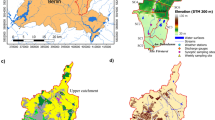Abstract
It is hypothesized that episodic introductions of road salt severely disrupt the soil nitrogen cycle at a range of spatial and temporal scales. A field-scale study has confirmed impacts on the nitrogen cycle in soil, soil solution and river samples. There is evidence that ammonium-N retention on cation exchange sites has been reduced by the presence of sodium ions, and that ammonium-N has been flushed from the exchange sites. Increases in soil pH have been caused in naturally acidic uplands. These have enhanced mineralization of organic-N, especially nitrification, leading to a reduction in the mineralizable-N pool of roadside soils. There is evidence to support the hypothesis that organic matter content has been lowered over decades either through desorption or dispersal processes. Multiple drivers are identified that contribute to the disruption of nitrogen cycling processes, but their relative importance is difficult to quantify unequivocally. The influence of road salt on soil and soil solution declines with distance from the highway, but impacts on water chemistry in a local stream are still strongly evident at some distance from the road.








Similar content being viewed by others
References
Amrhein, C., Strong, J. E., & Mosher, P. A. (1992). Effect of deicing salts on metal and organic-matter mobilization in roadside soils. Environmental Science and Technology, 26, 703–709.
Bäckström, M., Karlsson, S., Backman, L., Folkeson, L., & Lind, B. (2004). Mobilisation of heavy metals by deicing salts in a roadside environment. Water Research, 38, 720–732.
Clark, M. J., Cresser, M. S., Smart, R., Chapman, P. J., & Edwards, A. C. (2004). The influence of catchment characteristics on the seasonality of nitrogen species concentrations in upland rivers of Northern Scotland. Biogeochemistry, 68(1), 1–19.
Duckworth, C. M. S., & Cresser, M. S. (1991). Factors influencing nitrogen retention in forest soils. Environmental Pollution, 72, 1–21.
Dytham, C. (2003). Choosing and using statistics: A biologist’s guide (2nd ed.). Oxford, UK: Blackwell.
Green, S. M., Machin, R., & Cresser, M. S. (2007). Effect of long-term changes in soil chemistry induced by road salt applications on N-transformations in roadside soils. Environmental Pollution (in press). 10.1016/j.envpol.2007.06.005.
Grolimund, D., Borkovec, M., Barmettler, K., & Sticher, H. (1996). Colloid-facilitated transport of strongly sorbing contaminants in natural porous media: A laboratory column study. Environmental Science and Technology, 30, 3118–3123.
Norrström, A. C., & Bergstedt, E. (2001). The impact of road de-icing salts (NaCl) on colloid dispersion and base cation pools in roadside soils. Water Air and Soil Pollution, 127, 281–299.
Peinemann, N., Guggenberger, G., & Zech, W. (2005). Soil organic matter and its lignin component in surface horizons of salt-affected soils of the Argentinean Pampa. Catena, 60, 113–128.
Shainberg, I., & Letey, J. (1984). Response of soils to sodic and saline conditions. Hilgardia, 52, 1–57.
Smart, R., White, C. C., Townsend, J., & Cresser, M. S. (2001). A model for predicting chloride concentrations in river water in a relatively unpolluted catchment in north-east Scotland. Science of the Total Environment, 265, 131–141.
Acknowledgements
We are grateful to NERC, DERFA and the University of York for financial support for this research. Gratitude is also extended to Natasha Blake and Rebecca Sutton for assistance with experimental work and Dr. Malcolm Glendenning at CASS, University of Leeds, UK for the ICP-OES analysis.
Author information
Authors and Affiliations
Corresponding author
Rights and permissions
About this article
Cite this article
Green, S.M., Cresser, M.S. Nitrogen Cycle Disruption through the Application of De-icing Salts on Upland Highways. Water Air Soil Pollut 188, 139–153 (2008). https://doi.org/10.1007/s11270-007-9530-x
Received:
Accepted:
Published:
Issue Date:
DOI: https://doi.org/10.1007/s11270-007-9530-x




